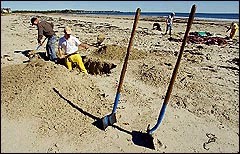|
The beaked whale that washed onto Parsons' Beach in Kennebunk drew special interest because the species is rarely seen alive or dead. They swim offshore, diving in the deep ocean waters for fish and squid.
Scientists who examined the 15-foot-long whale Friday could not say which species of beaked whale it was or estimate its age.
"There's just really not that much known about these animals," said Erica Gebhart of the University of New England's Marine Science Education and Research Center, which helped with the examination.
Researchers collected tissue and bone samples and planned to examine its head using a CT scan. They also removed the whale's uterus, which contained an unborn calf perhaps 12 inches long.
"You don't like to see that. You know, it's bad enough already," said Heather Koopman of Woods Hole Oceanographic Institution, which sent a team to conduct the exam.
The researchers eventually cut up the carcass and buried the flesh in the sand. The skeleton was saved for the Smithsonian Institution.
There were no obvious signs of injury that might have killed the whale. "It had no evidence of being hit by a boat or of a fisheries entanglement," Koopman said.
The 40- to 50-foot-long humpback whale was found floating and was towed onto Pemaquid Beach, where it also was examined Friday. There was no immediate sign of injuries to that whale either, Liles said.
At least two of the minke whales found last month had marks in their flesh that appeared to have been caused by fishing lines or nets. It wasn't immediately clear what type of gear - nets or lines - caused the marks or whether entanglement caused the deaths.
One of the minkes had an unusual square-shaped cut in its abdomen, fueling speculation that it had been lanced in order to sink it and conceal it.
Killing or harming whales and other marine mammals is prohibited by the U.S. Marine Mammal Act.
Federal and state officials said Friday they still don't know the cause of any of the whale deaths or what role fishing gear is playing in the phenomenon.
They met last week with representatives of the herring trawler fleet that has been dragging nets through schools of herring along the Maine coast. Herring also provide food for large fish and whales, including minkes and humpbacks. Although some are pointing fingers at the trawlers, the representatives who attended the meeting said there had been no reports of whales in their nets.
It is expected to take months to analyze the tissue samples and other evidence collected from the whales. An investigation into the discovery of more than 10 large whale carcasses offshore in July is still not complete, although officials suspect those deaths were caused by toxic algae that was poisoning their food supply.
Food poisoning also will be one of the potential factors investigated in the more recent whale deaths. The discovery of carcasses in the past three weeks coincides with an unusually severe occurrence of toxic red tide algae along the Maine coast. The toxin in red tide algae builds up in shellfish and fish and is highly poisonous to people and whales.
Researchers said they also will look for damage to the ears of the beaked whale. Low-level underwater sonar used by the U.S. Navy has been linked to whale deaths in other parts of the world, though Liles said it is not believed to have been a factor here.
After the discovery of the beaked whale, state and federal officials theorized that there may well be multiple causes of the deaths, coinciding in time.
Because beaked whales swim in different waters and eat different prey than minkes and humpbacks, it's less likely that any one cause - such as fishing-gear entanglements or food poisoning - could have killed them all.
"It's hard to think of an event that could explain all of these findings," Liles said.
Staff Writer John Richardson can be contacted at 791-6324 or at:
jrichardson@pressherald.com
Top
|
